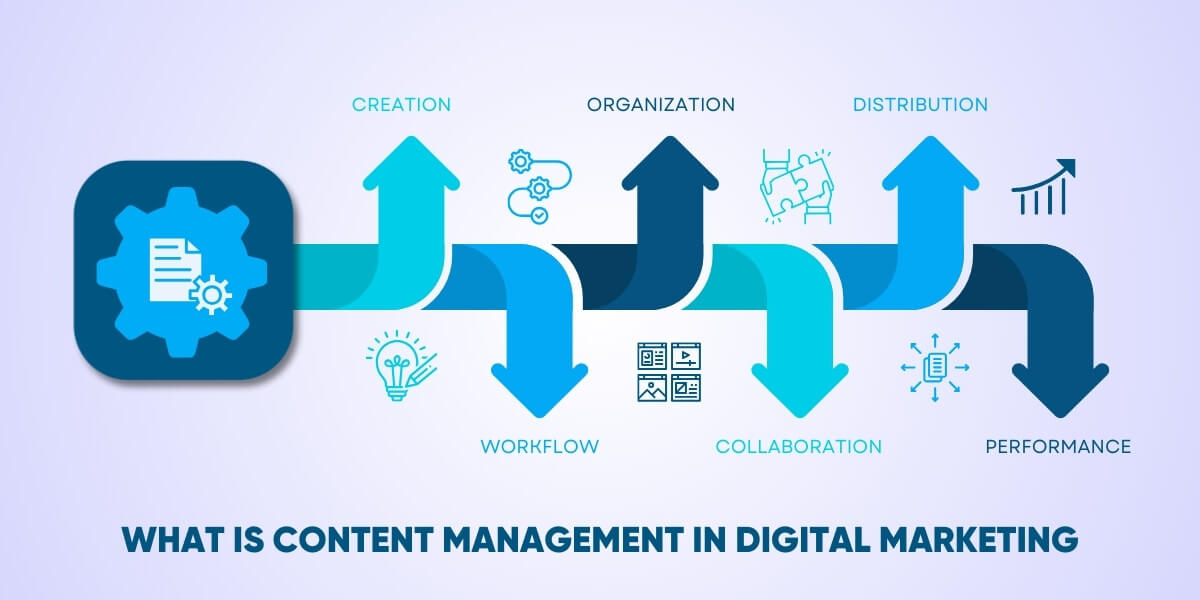Content Management Essentials for Digital Marketers
In the fast-paced realm of digital marketing, effective content management is crucial for shaping brand identity, engaging audiences, and driving business growth. Content Management in Digital Marketing delves into the strategies, tools, and best practices essential for navigating the ever-evolving digital landscape. This comprehensive guide explores how businesses can harness the power of content to connect with their target market, build credibility, and foster lasting relationships with customers.
From creating compelling content to optimizing distribution channels, this title offers valuable insights to help marketers craft a cohesive content strategy that resonates in the digital sphere. Join us on a journey to discover the art and science of content management in the dynamic world of digital marketing.
Key Takeaways
- Content management entails planning, creating, optimizing, organizing, distributing, promoting, and analyzing marketing content.
- It improves collaboration, brand consistency, content reuse, SEO, and, ultimately – the customer experience.
- A structured content strategy and effective workflows are vital for successful content management.
- Use a CMS platform to simplify authoring, collaboration, distribution, and insights for your content.
- Adopt best practices like quality-focused creation, governance policies, modular content, and integrated tech stack.
- Continuously analyze and optimize content by listening to your audience.
What is Content Management?
Content management refers to the process of creating, reviewing, editing, storing, publishing, and analyzing content on websites, blogs, and other marketing channels. It may involve different formats, such as text, images, videos, PDFs, and infographics.
The core components of content management include:
- Content Creation: Developing and authoring new content like blog posts, articles, social media updates, emails, and ebooks.
- Content Editing: Reviewing and editing content for grammar, brand consistency, readability, and optimization.
- Content Workflow: Managing the content creation and review process across teams like writers, editors, and graphic designers.
- Content Optimization: Optimizing content for search, user experience, and conversions.
- Content Governance: Establishing guidelines for tone of voice, branding, SEO, metadata, and formats.
- Content Publishing & Distribution: Publishing content on websites, automated marketing emails, and social media distribution.
- Content Analysis: Tracking and analyzing content performance with metrics like views, engagement, and conversions.
- Content Storage & Organization: Storing content in a structured format and taxonomy so it can be easily searched and reused.
Why is Content Management Important?
Here are some key reasons why content management should be a priority for digital marketers today:
- Improves Content Workflows: Content management systems streamline collaboration between teams such as content creators, reviewers, and publishers. Automated workflows ensure content moves smoothly from creation to publication.
- Enables Content Reuse: Stored content can be repurposed and reused across multiple channels, saving time and resources.
- Maintains Brand Consistency: Centralized content guidelines and workflows ensure on-brand messaging across channels.
- Provides Content Insights: Content analytics from CMS platforms help understand engagement and optimize content.
- Enhances Customer Experience: Structured, high-quality content provides a seamless experience across channels.
- Boosts SEO & Conversions– Optimized and relevant content improves search rankings and drives conversions.
- Future-Proofs Content: With a CMS, content can be quickly published across new channels and platforms.
- Saves Time & Resources: Streamlined content management workflows save time and effort over creating content manually.
How Content Management Process Works
Managing content involves several strategic steps:
Audit Existing Content
The first step is to audit your existing content across websites, blogs, social media, and other channels. Analyze content types, topics, formats, metadata, volume, engagement, etc. This helps uncover content gaps, outdated assets, opportunities for consolidation, and content reuse.
Define Content Strategy
Next, develop a content strategy and content calendar to create content that delivers value for your brand and audience. Set goals, analyze competitors, and determine content topics, formats, publishing cadence, and promotion strategy across different channels.
Create & Optimize Content
With the content strategy as your guide, start creating high-quality content optimized for SEO and users. Involve teams like writers, designers, and developers. Ensure brand consistency and implement content guidelines.
Manage Content Workflow
Streamline your team’s content creation and review process through workflows. This includes creating content, submitting it for review, editing, final approval, metadata tagging, image optimization, and scheduling publication.
Distribute & Promote Content
Publish approved content on your owned channels, such as your website, blog, and social media. Distribute to other channels through organic search, paid ads, influencers, and email marketing. Promote your content through social media, email, and other tactics.
Analyze & Improve
Leverage analytics from your CMS, social media, and web analytics platforms. Look at engagement metrics, conversions, and search ranking improvements to optimize content. Refresh outdated content assets when needed.
This content production, optimization, distribution, promotion, and analysis cycle continues as you track performance and learn more about your audience.
What is the Role of a Content Management System (CMS)
Content management system (CMS) software makes content management easier for digital marketing teams. Popular examples are WordPress, Drupal, and Joomla.
Here are some key benefits of using a CMS:
- It provides an intuitive interface for authors, editors, and publishers to manage content.
- Offers built-in workflows for streamlined content creation, reviews, and approvals.
- Includes SEO features like metadata fields, URL structures, and XML sitemaps.
- Options to schedule and automate content publishing to different channels.
- Inbuilt analytics to track engagement and conversions for each content asset.
- Allows cross-channel content syndication and omnichannel experiences.
- Simplifies content audits with content tagging, search, and reporting.
- Central content repository for easy storage, organization, and Reuse.
- The Plugin ecosystem provides added CMS features and integrations.
- Scalable infrastructure to manage large content volumes.
- Role-based access control improves collaboration.
With a CMS, you don’t have to build content features from scratch. The platform handles the technical aspects while you focus on strategy and quality.
Steps for Creating a Powerful Content Management Strategy
An effective content management strategy aligns with your overall business and digital marketing objectives. Here are some tips to create one:
- Audit Content Landscape: Thoroughly evaluate your existing content types, performance, gaps, and opportunities.
- Define Goals: Whether boosting conversions, brand awareness, reducing bounce rates, or traffic goals: be clear on what you want to achieve.
- Personas & Journeys: Create detailed buyer personas: map content to different stages of their journey.
- Map Content Across Channels: Audit each channel and create a channel-specific content strategy and calendars.
- Governance Guidelines: Define content branding guidelines, formatting, SEO and metadata practices, and legal compliance.
- Technology Stack: Choose a CMS platform, marketing automation, and analytics tools that will support your strategy.
- Production Workflow: Establish an end-to-end workflow: content request, creation, review, approval, publishing, distribution, promotion, and analysis.
- Enable Reuse and repurposing: Ensure content is componentized and tagged so it can be reused across channels and for different stages.
- Collaboration Tools: Use collaboration tools to manage requests, assign tasks, share feedback, and track progress.
- Quality over Quantity: Focus on high-quality, useful content rather than chasing vanity metrics like volume.
- Analyze & Optimize: Use analytics dashboards and reports to track content KPIs. Continuously test and improve.
- Iterate: Regularly audit your strategy and improve processes. Adapt to new opportunities and audience preferences.
With a sound content strategy, you can cost-effectively scale content production and distribution, ultimately leading to better customer experiences.
Content Management Best Practices
Here are some key best practices to succeed with content management:
- Centralize Content: Use a CMS to store all content in one place for easy management.
- Modular Content: Structure content so it can be broken into reusable components like quotes, stats, and paragraphs.
- Streamline Workflows: Automate repetitive tasks like image compression, metadata tagging, and scheduling through workflows.
- Content Guidelines: Create clear guidelines for branding, formatting, SEO, writing style, and assets.
- Cross-Channel Optimization: Adapt content across channels while retaining core messaging.
- Focus on Quality: In-depth, well-researched, and useful content drives more value than superficial content.
- Optimized For Users: Write actionable content that solves users’ questions and needs.
- Promote Your Content: Amplify your content through emails, social media, PR, influencers, and ads.
- Analyze Performance: Use metrics like dwell time, links, search traffic, shares, and engagement to optimize content.
- Refresh Content: Update stale content by adding new stats, examples, trends, and seasons.
- Listen to Audience: Analyze user searches, comments, shares, and surveys to create content they want.
- Mobile-First Mindset: With increasing mobile usage, optimize the content experience for mobile visitors.
By following structured content management processes and best practices, you can gain valuable insights while future-proofing your content assets. This builds brand authority, improves conversion rates, and strengthens customer relationships over the long term.
Best Content Management Tools & Software
Here are some popular tools and platforms for content management:
- Content Management Systems: WordPress, Drupal, Joomla, Sitecore, Webflow
- Digital Asset Management: Adobe Experience Manager, Bynder, Brandfolder
- Marketing Automation: HubSpot, Marketo, Eloqua, Pardot
- SEO Tools: Yoast SEO, Moz Pro, SEMrush
- Analytics: Google Analytics, Parse.ly, Simple Analytics, BuzzSumo
- Collaboration: Google Drive, Trello, Asana, Slack, Microsoft Teams
- Live Chat: Drift, Intercom, Zendesk
- CRM / CX: Salesforce, HubSpot, Zoho CRM
- Hosting: WPEngine, Bluehost, SiteGround, HostGator
- Headless CMS: Contentful, Strapi, Ghost, Directus
When evaluating tools, ensure they integrate well with each other and with your tech stack. This enables seamless content sharing and reduces duplicated efforts.
What are the Components of a CMS?
Modern CMS platforms provide several built-in components to make content authoring easier:
- Page Builder: Drag and drop page builder to build quickly and lay out pages using pre-built modules.
- Media Manager: Upload, store, and organize images, videos, and files in a central media library.
- Templates: Professionally designed templates for common pages like services, Contact Us, and blogs.
- Forms: Create and embed forms for lead generation, customer surveys, and registrations.
- SEO: SEO-friendly URL structure, title & meta tags, XML sitemap generator.
- Workflows: Automated workflows route content through review, approval, and publishing processes.
- Personalization: Tools to deliver personalized content based on visitor attributes.
- Content Translation: Built-in or integrated translation services to manage multilingual content.
- Mobile Responsiveness: Preview sites across devices and make them mobile-friendly.
- Analytics: Analytics to track and optimize user engagement and conversions for each content asset.
- APIs: APIs to connect CMS with other marketing, analytics, ecommerce, and CRM tools.
- Together, these features provide an end-to-end content management experience optimized for digital marketing results.
What Factors to Consider for Exploring the Different Content Types
Here are some key considerations when managing different content formats:
- Blog / Articles: Focus on quality over quantity. Promote new blogs through email and social media. Track visitors, lead generation, shares, links, and search traffic.
- Videos: Optimize videos for search with transcriptions. Share natively on YouTube and social media, tracking completion rates and engagement metrics.
- Podcasts: Publish podcasts on platforms like Spotify. Promote episodes through clips on social media. Analyze listeners, subscribers, and downloads.
- eBooks / Whitepapers: Gate long-form content behind lead generation forms. Track downloads and email metrics. Repurpose content into blogs and videos.
- Webinars: Host interactive webinars behind registration forms. Record and repurpose as video content.
- Social Media: Schedule and reuse content across platforms using social media management tools: track engagement, clicks, and conversions.
- Website Pages: Ensure important pages are secure and mobile-friendly and use recent content. Track user behavior using heatmaps and funnel reports.
- Fine-tuning content and promotion strategies based on performance data from each channel gives better results.
The Bottom Line
Marketing success hinges on providing value through excellent content that educates and engages your audience. But creating great content is only half the equation. Managing the entire content lifecycle: from planning to optimization and distribution: is equally crucial.
With a strategic, structured approach to content management, you can streamline workflows, maintain brand consistency, reuse content, get actionable insights, and drive growth across channels. While it takes effort, the payoff of enhanced customer experiences and measurable business impact makes it worthwhile. Leverage technology like CMS platforms but keep your audience at the center.
With robust content management, you can build trust, strengthen relationships, and cement your brand’s authority. In many ways, how you manage content defines your digital marketing success.
Frequently Asked Questions
What are the benefits of content management?
Improves workflows, enables content reuse, maintains brand consistency, provides analytics, and enhances customer experience.
What should a content strategy include?
Goals, audience personas, content mapping across channels, governance guidelines, workflows, and collaboration process.
How can I optimize my content?
Focus on quality, structure it for SEO and user experience, promote it across channels, and continuously analyze and refine it.
What are some key content management best practices?
Centralize content, modular structure, automate workflows, optimize for users, promote content, and keep it fresh.
What tools can help with content management?
CMS platforms, marketing automation, analytics tools, collaboration software, and social media management tools.
How do I create a content production workflow?
Planned content, briefed writers, created, reviewed/edited, optimized media, approved, scheduled publishing, promoted, and analyzed.



